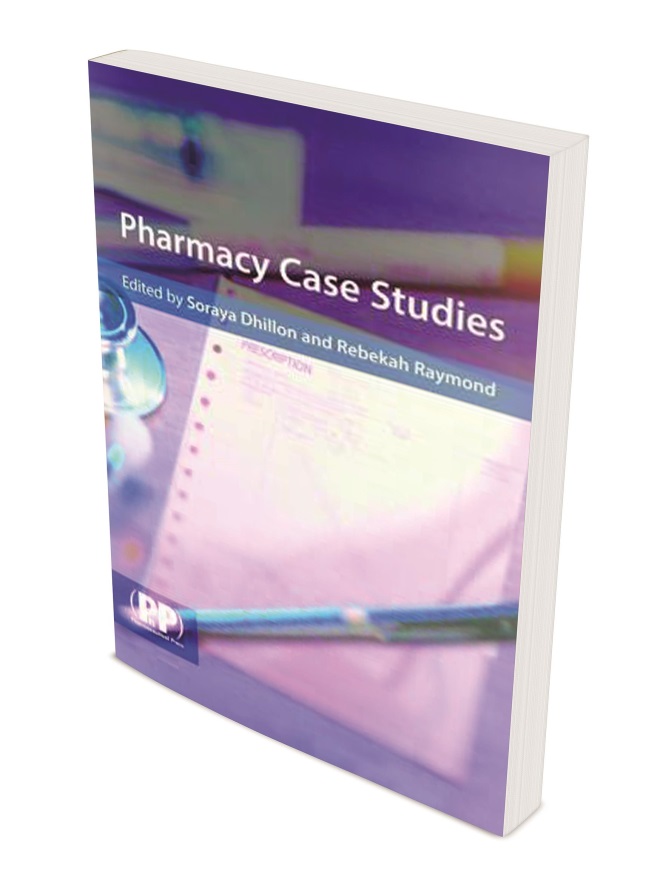
General Pharmaceutical Council (GPhC)
Case scenario
Mr AB, a 21-year-old pharmacy student, came to the local pharmacy last week with a seven-day prescription for diazepam 10mg tablets, one to be taken at night. The drug was prescribed to him by his GP because around five weeks ago Mr AB started suffering from insomnia. In fact, although he is typically supposed to wake up at 7:00am to attend his lectures, at 4:00am he is already fully awake. He does not find it difficult to fall asleep, nor does he wake up too frequently during the night. During the day, he feels very tired, anxious and tearful. It is now three days since the pharmacist dispensed his prescription and Mr AB has returned to the pharmacist because he claims he is still not able to sleep properly.

Source: Pharmaceutical Press
Case discussion
This discussion, adapted from
Pharmacy Case Studies
[1], published by Pharmaceutical Press, highlights the main questions to be considered in managing Mr AB’s case. For more information on the diagnosis and treatment of insomnia, please refer to ‘Sleep disorders: diagnosis’ and ‘Sleep disorders: treatment’.
How is insomnia defined?
Insomnia is characterised by the incapacity to sleep and/or to remain asleep for a reasonable period, which may vary from individual to individual. The sleep disturbance is observed at least three times per week and for at least one month.
What are the risk factors for the development of insomnia? Does Mr AB have any of the risk factors for developing insomnia?
Some of the most common risk factors for the development of insomnia are:
- Depression; typically, depressed individuals wake up earlier than usual (e.g. at least two hours before the scheduled time). For this reason, in the case presented, one might suspect the existence of an underlying depression.
- Excessive use of alcohol; excessive use of caffeine: Mr AB might have recently increased his alcohol intake. A possible recent increase in caffeine intake might be associated with the need to cope with his pending academic commitments.
- Stress, pain: Mr AB may be suffering from a short-term, exam-related, stressful situation.
- Hypomanic/manic episodes: in people with bipolar disorder.
- Circadian rhythm sleep disorders: jet lag; insomnia experienced by shift workers; and delayed sleep phase syndrome (sometimes seen in students who are enjoying their first experiences outside the family environment and who go to bed too late). This is something that should be discussed with the present client.
- Nocturnal polyuria, sometimes observed in conditions such as diabetes, kidney diseases, prostate enlargement, hormonal imbalances, use of diuretics.
- Sleep apnoea: interrupts the normal breathing stimulus of the central nervous system and the person must actually wake up to resume breathing.
What group of drugs does diazepam belong to? What are the main pharmacokinetic differences between the components of this class of drugs?
Diazepam is a benzodiazepine. Diazepam is more reliably absorbed following oral rather than intramuscular administration. This may be caused by precipitation in the muscle. Diazepam appears to undergo enteroÂhepatic recirculation with a second plasma peak occurring four to six hours after initial administration. This may be associated with re-sedation. Diazepam is oxidised in the liver to active metabolites including desmethyldiÂazepam (nordiazepam), which has a half-life of over 100 hours. Benzodiazepine oxidation may be impaired in patients with liver disease and in some elderly patients. Metabolism of benzodiazepines, such as oxazepam and lorazepam, is not impaired in the elderly and in those with liver dysfunction.
Benzodiazepines have five major clinical indications:
- as anti-anxiety agents;
- as sedative hypnotics;
- as anticonvulsants;
- as muscle relaxants;
- as amnestic agents.
This five-fold clinical activity is possessed, to a greater or lesser extent, by all benzoÂdiazepines in current clinical use. The properties of benzodiazepines make them ideally useful for managing anxiety (e.g. diazepam, chlordiazepoxide, lorazepam); insomnia (e.g. diazepam, temazepam, nitrazepam, loprazolam, Âflurazepam, lormetazepam); epilepsy (e.g. clobazam, diazepam, lorazepam); sports injuries where muscle relaxation is required (e.g. diazepam) and as premedications prior to surgery (e.g. midazolam, lorazepam). The benzodiazepines have a number of other uses, including management of alcohol withdrawal Âsyndrome (e.g. chlordiazepoxide, diazepam) and restless legs (clonazepam). Short duration of action may be useful (e.g. for falling asleep), although longer Âduration of action may be desired (e.g. in treatment of sleep-maintenance disturbances or for seizure control).
Among the different benzodiazepines, large variation exists in respect to their pharmacokinetic properties. Those benzodiazepines that have the long-acting metabolite N-desmethyldiazepam in common (e.g. diazepam, prazepam, clorazepate) are eliminated relatively slowly, others are metabolised rather rapidly (e. g. oxazepam, temazepam, triazolam). Pharmacokinetic parameters constitute the basis for a rational dosage regimen. In anticonvulsant and anti-anxiety treatment, stable blood levels of the drug are pursued so that compounds with long elimination half-lives of parent drug or active metabolites are of advantage. Conversely, if a benzodiazepine is taken as an hypnotic, the duration of action should be restricted to the night, hence a compound with a short elimination half-life is preferred.
What is the mechanism of action of diazepam in the treatment of insomnia?
Benzodiazepine agonists and other agonist ligands at the benzodiazepine site achieve their therapeutic effects by enhancing the actions of the inhibitory Âneurotransmitter gamma-aminobutyric acid (GABA) at its receptor. BenzoÂdiazepines have a binding site on the GABA-A receptor, which forms a channel through the membrane and opens and closes to control chloride flow into the cell. When benzodiazepine agonists act on their receptor site, GABA produces a more frequent opening of the channel, so that the flow of chloride is increased. As a result, the neuron will be less likely to go through depolarisation, which ultimately results in neuronal inhibition. For this reason, all GABAergic drugs produce sedation. Type I and type II GABA receptors have been identified; benzoÂdiazepines bind with relative non-selectivity to both types. There are several other drugs that are also ligands of the GABA–chloride ion receptor complex, notably barbiturates, chloral hydrate and the newer non-benzodiazepine hypnotics, zopiclone, zolpidem and zaleplon (‘Z’-drugs). The Z-drugs are likely to possess smaller residual next day Âsequelae than clinically equivalent doses of most benzodiazepines.
What are the side effects of diazepam?
Any prescription for benzodiazepines must be preceded by a careful risk–Âbenefit analysis considering the issues of an individual’s particular life situation, Âpersonality style and psychiatric diagnosis. Risks of both abuse and cognitive or psychomotor impairments have to be balanced against therapeutic benefits.
The most common side effects of benzodiazepines in routine clinÂical use are drowsiness, muscle weakness, lightheadedness, dizziness, ataxia, dysarthria, blurring of vision, confusion and apathy. Because of pharmacokinetic changes of pro-nordiazepam molecules (e.g. diazepam) associated with ageing, the elderly may be at increased risk. There may be an association between benzoÂdiazepine use and the risk of falls and/or hip fractures in the elderly. For those benzodiazepines given at bedtime for sleep induction and/or sleep maintenance in patients with insomnia, the problem arises when the clinically desired effect of nocturnal sedation carries over into the early part of the next day. Patients who work in any high accident risk environment (e.g. with heavy machinery), as well as those where cognitive failure could cause accident to themselves or others, should be warned about possible interactions of benzodiazepines with alcohol. Finally, increased hostility and aggression (‘paradoxical effects’) can sometimes be observed following ingestion of these drugs, especially in borderline personality disorders and in the elderly. Both benzodiazepines and newer non-benzodiazepine molecules possess a significant addiction liability; typical rebound and withdrawal symptoms may be observed if the drug is not carefully titrated down.
What formulations are available for diazepam?
Diazepam formulations include:
- Tablets: 2mg; 5mg; 10mg.
- Oral solution: 2mg/5ml.
- Strong oral solution: 5mg/5ml
- Injection (solution): diazepam 5mg/ml.
- Formulation for intravenous injection or infusion (emulsion): 5mg/ml.
- Rectal solution: 2mg/ml; 1.25ml (2.5mg); 2.5ml (5mg) tube; 4mg/ml, 2.5ml (10mg).
- Suppositories: 10mg.
- Dental prescribing on NHS: tablets or oral solution 2mg/5ml.
What alternative preparation(s) could the pharmacist recommend for Mr AB?
Diazepam is better indicated if insomnia is associated with daytime Âanxiety. Other benzodiazepines prescribed for insomnia include: nitrazepam, flurÂazepam, loprazolam, lormetazepam and temazepam. The non-benzodiazepine hypnotics zaleplon, zolpidem and zopiclone are not licensed for long-term use. The sedative antipsychotic promethazine hydrochloride is sometimes used to facilitate sleep, with a 25–50mg Ârecommended dose. Melatonin has proved effective for some clients, mostly in regulating the sleep/waking cycle. Although evidence of efficacy is limited, some clients use herbs such as valerian and chamomile. If Mr AB will finally be diagnosed with depression, a trial with an antiÂdepressant will be indicated.
What counselling could the pharmacist give Mr AB to help try and resolve the issue?
Relevant sleep hygiene issues may be discussed with the client. Some Âtraditional remedies for insomnia have included drinking warm milk before bedtime, taking a warm bath in the evening, exercising vigorously for half an hour in the afternoon, having only a light evening meal, avoiding mentally stimulating activities in the evening hours, and making sure to get up early in the morning and to go to bed at a reasonable hour. Mr AB should seriously consider the Âpossibility of tapering down gradually his caffeine intake and might want to avoid any excessive intake of alcohol. Distractions in the bedroom, including excessive light and noise (e.g. from television) should be avoided. Finally, Mr AB should be informed that with a continuous, long-term (e.g. more than 3–12 weeks), prescription of benzodiazepines, both tolerance and dependence have been described.
Fabrizio Schifano, MD, MRCPsych, Dip Clin Pharmacology is Chair in Clinical Pharmacology & Therapeutics, School of Pharmacy & Associate Dean, Postgraduate Medical School, University of Hertfordshire; Honorary Consultant Psychiatrist.
References
[1] Pharmacy Case Studies by Soraya Dhillon and Rebekah Raymond. Pp 471 £29.99. London: Pharmaceutical Press; 2009. ISBN 978 0 85369 724 4
General references
Breimer DD, Jochemsen R & von Albert HH. Pharmacokinetics of benzodiazepines. Short-acting versus long-acting. ArzneimittelÂforschung 1980;30:875–881. PMID: 6106488
Curran HV, Schifano F & Lader MH. Models of memory dysfunctions? A comparison of the effects of lorazepam and scopolamine on memory, psychomotor performance and mood. Psychopharmacology (Berlin) 1991;10:83–90. PMID: 2006245
Hindmarch I. Medicines in the workplace: the effects of prescribed and OTC drugs on performance. In: Ghodse AH (ed.) Addiction at Work: Tackling Drug Use and Misuse in the Workplace. London: Gower Publishing Ltd; 2015.
Joint Formulary Committee. British National Formulary 55. London: British Medical Association and Royal Pharmaceutical Society of Great Britain, March 2008.
Leger D, Guilleminault C, Dreyfus JP et al. Prevalence of insomnia in a survey of 12,778 adults in France. Journal of Sleep Research 2000;9:35–42. doi:10.1046/j.1365-2869.2000.00178.x
Schifano F. (1991) Ansiolitici benzodiazepinici (alprazolam, bromazepam, camazepam, clobazam, clorazepato dipotassico, clordiazepossido, clotiazepam, delorazepam, diazepam, estazolam, flunitrazepam, Âfluoresone, flurazepam, glaziovina, lorazepam, lormetazepam, meÂbutamato, medazepam, meprobamato, nitrazepam, nordiazepam, oxazepam, pinazepam, prazepam, temazepam, triazolam, valnottamide). In: Casiglia E and Gava R (eds) L’Annuario dei Farmaci. Farmacologia Clinica e Terapia. Padova: Piccin Nuova Libraria, (I), pp. 111–129.
Schifano F. (2005) Substance misuse in the workplace. In: Ghodse AH (ed.) Addiction at Work: Tackling Drug Use and Misuse in the Workplace. London: Gower Publishing Ltd.
Schifano F & Magni G. Panic attacks and major depression after discontinuation of long-term diazepam abuse. Drug Intelligence and Clinical Pharmacy; the Annals of Pharmacotherapy 1989;23:989–990. PMID: 2603456
You might also be interested in…
The importance of diverse clinical imagery within health education

Government should consider ways to prevent ‘inappropriate overseas prescribing’ of hormone drugs, review recommends
